Electoral Reform for the House of Representatives
By Peter Crayson
Abstract
The problem that this paper addresses is that there is often
a very significant disparity between the will of the people, as expressed
in their two-candidate preferred votes, and the number of seats won by
each party in the House of Representatives. The disparity can be so pronounced
that a party with a minority of votes can quite easily end up winning a
large majority of seats. Thus, although one's local member may be a reflection
of the will of the people in the electoral division, the overall composition
of the House, and thus the choice of the party of government, is clearly
not a reflection of the will of the people. Majority representation, and
thus Government, is won not so much by the vote of the people but by accident
of the electoral boundaries which, in a sense, makes voting quite redundant.
At the last federal election, the ALP obtained 50.52% of the national
total of two-candidate preferred votes but only obtained 45.27%
of the seats, whereas the Coalition obtained 48.31% of the national
total of two-candidate preferred votes but obtained 54.05% of the
seats. Though I have yet to conduct further research, I suspect that this
disparity is typical, even to such an extent that the democratic and representative
nature of our system could be seriously questioned, not to mention the
oft-heard claim of governments to a "mandate".
Of the changes I propose changes to the House of Representatives
electoral system, the key feature is:
-
to effectively guarantee that the percentage of seats obtained
by the party with a majority of the national total of two-candidate preferred
votes will in all cases be as far as is practicable equal
to the percentage of House of Representatives seats won by that party.
Other features of the system are:
- to enable the vote of all electors - even those
in "safe" seats - to count not only in electing a local member, but to
count equally with all other electors in the determination of the composition
of the entire House of Representatives, and thus in the determination of
the governing party ... and thus, in a sense, for a Prime Minister.
- to retain single-member electorates but to eliminate any
inordinate pragmatic focus on "marginal seats"; and
- to provide for representation of minor parties without
the threat of a hung Parliament by allocating seats from a party list;
- to enable high quality, or highly valued candidates (in
the judgement of a party), such as party leaders and senior ministers,
to be elected to party list seats - which do not require electorate duties -
in order that they may devote their full energies to their portfolios.
The first few party list seats may be considered
"safe seats" on a party list.
The system involves a mixture of electorate seats and national
party list seats, and also enables parties which may have obtained a significant
national total of primary votes but which obtained no electorate seats
to procure some representation in the House of Representatives. This proposal
also has some significant and positive ramifications pertaining to the
nature of, and for the case in favour of, a republic. At the last federal
election, had my system been in place, the ALP, with 50.52% of the national
total of two-candidate preferred votes would have obtained 50.72% of the
seats, whereas the Coalition, with 48.31% of the national total of two-candidate
preferred votes would have obtained 46.38% of the seats (see the spreadsheet
entitled "Results: Lib and NP in coalition, 100 electorate MPs").
My Spreadsheets
These spreadsheets illustrate the results that would have been obtained at each election of the House of Representatives from 1983 to 1988, and also look at differences in results with various parameters (number of electoral divisions, maximum supplementary seats, threshold percentage for top-up seats and ceiling for top-up seats) at different settings. These spreadsheets are aggregated into two Microsoft Excel worksheets, which you can download (they are zipped); if this doesn't work for you, e-mail me and I'll gladly send them to you.
Much of the following text refers to information on the spreadsheets, and I have copied here the spreadsheets pertaining to election of the House of Representatives from 1983 to 1988:
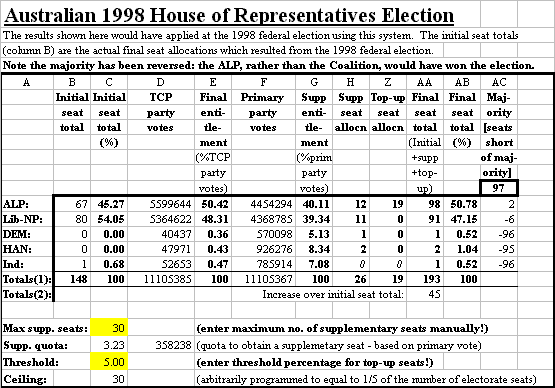
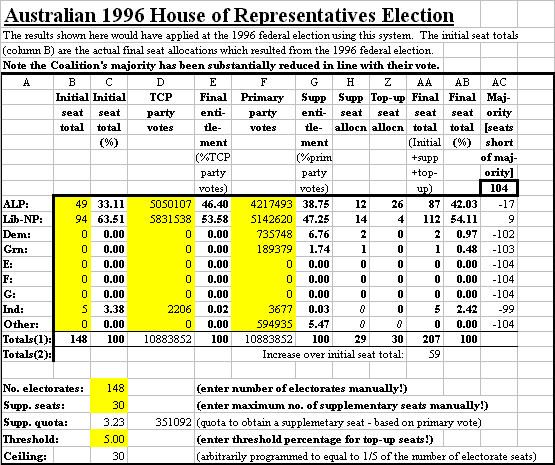
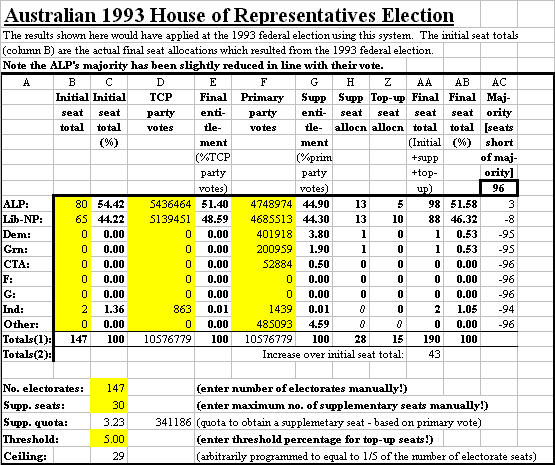
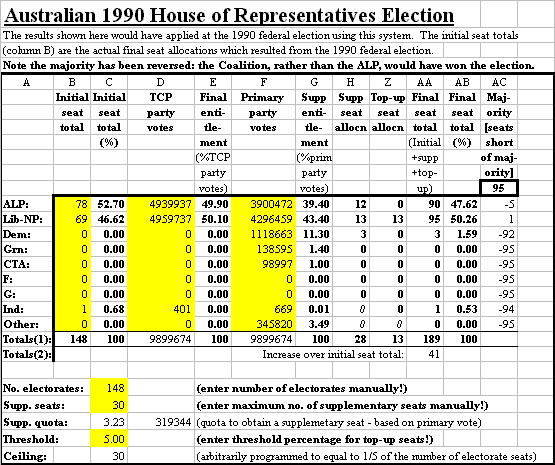
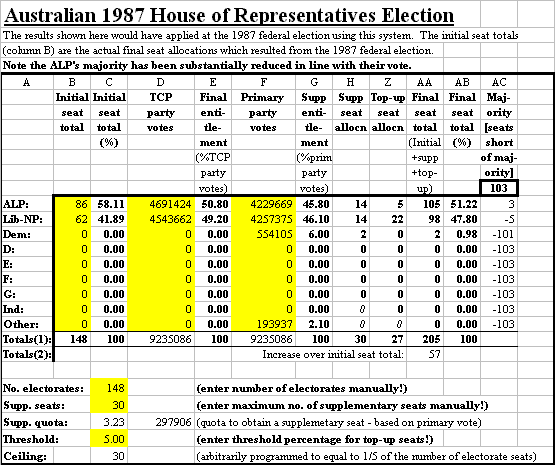
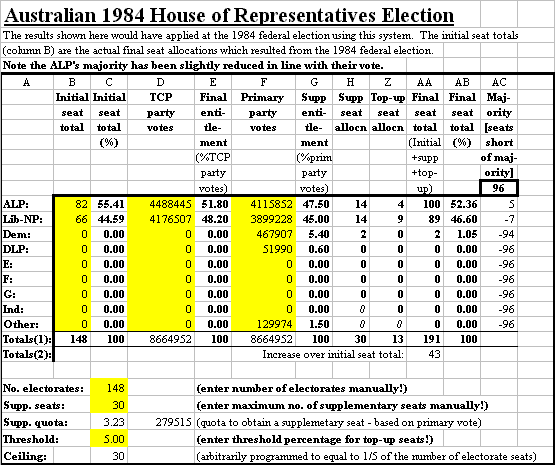
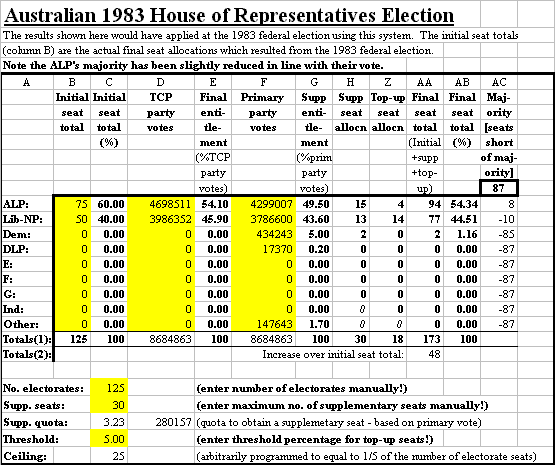
Method of Voting
The new electoral system can function using a method of voting
which is identical to the current system of voting. What changes here is
not the method of voting, but the method of counting the votes.
Changes to the Composition of the House of Representatives
Changes to the composition of the House of Representatives
would bear some similarity to the changes which have occurred to the composition
of the New Zealand House of Representatives under its MMP (Mixed Member
Proportional) system, but despite this similarity, there are a number of
important differences. (The New Zealand House of Representatives used to
include only M.P.s elected from single member electorates. It now includes
M.P.s elected from single member electorates plus M.P.s elected from a
national party list.)
Two sets of candidates would exist: electorate candidates
(standing for election as electorate M.P.s in single-member electorates
and elected by preferential voting which may be compulsory or optional)
and party list candidates (standing for election as list M.P.s - parties
would register a single national list with the Electoral Commission in
the same way that they register reference distributions for the Senate).
It is up to each party to decide whom it includes on the national list;
however, I would suggest that the logical choice would be for the party
leader to take the number 1 position with ministers/shadow ministers/portfolio
spokespersons taking, in order of precedence, subsequent positions, followed
by such number of other party members as may be deemed appropriate. A candidate
could stand as an electorate candidate only, as a list candidate only,
or both, but if a candidate standing as both an electorate candidate and
as a list candidate is elected as an electorate M.P., that person's name
would be struck from the party list.
List M.P.s
There are two categories of list M.P.s:
- Supplementary list M.P.s. A fixed maximum number of these
M.P.s, say, 20, are elected from the party list in proportion to the national
total of primary votes. This firstly ensures that top 5 or so positions
on party lists of the major parties are "safe seats". This enables party
leaders to concentrate on the national campaign during elections and to
concentrate on national issues during their term of office without having
to devote any of their valuable time and attention to a local electorate.
For the same reason, electorate M.P.s, being less likely to hold ministerial
office, would be in a better position to devote more time and attention
to their local electorate. Secondly, this enables parties which may have
obtained a significant nationwide primary vote, but which - due to the
nature of the preferential system - have not obtained any electorate seats
(such as the Australian Democrats) to obtain some representation in the
House of Representatives.
- Top-up list M.P.s. Even with the allocation of supplementary
list M.P.s, there may still be (and in fact probably still will be) a significant
disparity between the percentage of all seats held by each party and the
percentage of the national total of two-candidate preferred votes obtained
by that party. To correct this disparity, top-up seats are allocated (subject
to a predetermined minimum threshold of votes being required for entitlement
to any top-up list seats and a maximum ceiling on the total number of top-up
seats) to each party in such a manner that the percentage of seats obtained
by each party will very nearly be equal to the percentage of the national
total of two-candidate preferred votes obtained by the party, but even
more importantly, the party with a majority of the national total of two-candidate
preferred votes will in all cases obtain a majority of seats.
Predetermined Values
The following predetermined values should be entered into
the spreadsheet:
- The number of local electorates (i.e., electoral divisions).
I suggest that this be reduced from 148 to about 100, so that that total
of electorate M.P.s and list M.P.s works out at around 148.
- The maximum number of supplementary list seats. I suggest
that this be 20. The total number actually allocated will probably be a
little less than 30 as a seats are allocated according to the number of
quotas obtained by each party, and remaining partial quotas are discarded
(i.e., not distributed). (However, in order to fully allocate quotas amongst
the parties, it is possible that Senate-style pre-election registrations
of preference lists could be used to do this; in this case, the maximum
number of supplementary list seats would always be allocated.) The quota
is determined in the same way as the quota for a Senate seat; i.e, (100/(20+1))%
+ 1 vote.
- The threshold for top-up list seats. This is the lowest percentage
of two-candidate preferred votes required to be eligible for allocation
of a top-up list seat. I suggest that this be 5%.
- The ceiling for top-up list seats. I suggest that this be
30. This is the maximum number of top-up list seats which can be allocated,
excluding those which are used for "majority correction", where the party
with the majority percentage of two-candidate preferred votes has its numbers
boosted, if necessary, if it has not won at least that percentage of seats.
Top-up seats allocated for majority correction are unlimited in number,
but in practice the number would be small, and quite possibly zero. The
greater the disparity between the national percentage of two-candidate
preferred votes and the percentage of electorate seats for each party,
the greater the number of top-up list seats that will be required to rectify
the disparity.
Counting Votes and Allocating Seats
Votes would be counted exactly as they are counted under
the current system, and primary votes and two-candidate preferred votes
would be entered onto the spreadsheet. Nothing further needs to be done
- the final results are generated automatically by the spreadsheet. It
would take some space on these pages to describe the mathematics of the
process, though the mathematics is nothing more complicated than high school
level. You may easily examine the spreadsheets (including the equations
in the cells) and experiment with different figures to see how it works.
Alternative Method of Voting
The vote for a local electorate M.P. and the vote for a party/P.M.
could be separate, as it is in New
Zealand. This way, the vote for a local electorate M.P. would be conducted
in exactly the same way as at present, whilst a separate vote for a party
list would also be conducted. To do this, there would be a separate party
ballot paper containing squares to be marked preferentially in exactly
the same way as the ballot paper used to elect a local electorate M.P.
These ballots would then be counted, firstly counting the primary votes,
then allocating preferences in the same way as is done for each electoral
division, as though a single winner were to be determined. The result of
this count would give a two-party preferred vote, and this vote would be
used in the allocation of top-up seats. Though more democratic in that
it allows the voter to indicate separate choices - rather than having to
decide to use a single vote either for the local candidate or for the party
of preference - it is a little more complicated for the voter, and may
on this basis be less likely to appeal to politicians.
This is what the New Zealand House of Representatives
ballot paper looked like at the 1996 general election:
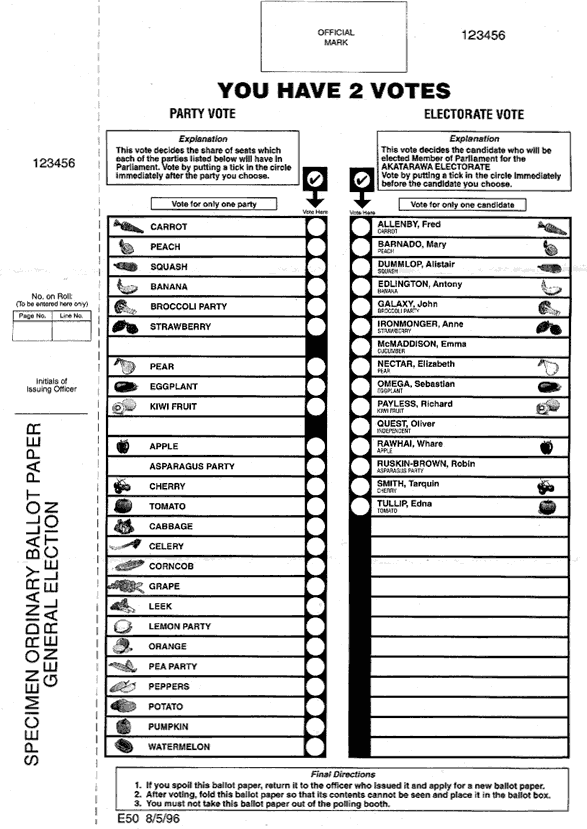
Under my system, the ballot paper would have the following
differences from that above:
- It would be split into and presented as two separate ballot
papers: the party ballot paper would resemble the left side of the above,
and the local M.P. ballot paper would resemble the right side of the above.
- Rather than ticking a box (which is used in non-preferential,
first past the post systems such as is used in New Zealand), if a square
(actually drawn on this ballot paper as circles!) is marked with an "X",
the registered preferences of the party (in the case of the party ballot
paper) or of the candidate (in the case of the local M.P. ballot paper)
would be applied. (This has the same effect as voting "above the line"
in the Senate. A similar method is used in South Australia, where a single
"1" in a square is used to indicate that the registered preferences be
applied.)
- Alternatively, a voter could number the squares (all squares
if compulsory preferential, or at least one square if optional preferential)
to indicate his or her own preferences.
Differences in Focus
Assuming that party leaders are at the top of their party
lists, for the first time ever, the entire nation will have the opportunity
to vote, in a sense, directly for a Prime Minister and for the party of
government. The claim to a mandate will thus have far more legitimacy.
Constitutional Implications - The Nexus
Section 24 of the Consitution requires that: "the number
of such members [of the House of Representatives] shall be, as nearly as
practicable, twice the number of senators." The effect of this condition
is most apparent at a joint sitting - it prevents a Government from legislating
to decrease the number of senators and increasing the number of M.H.R.s
so that the votes of the M.H.R.s would swamp the votes of the Senators.
This would have to be amended, as final numbers of M.H.R.s
in my system are always indefinite before an election. In its place, I
recommend that minimum numbers be specified for the senators and M.H.R.s.
Thus, I would make the following amendments to s24:
Original extract from s24:
... the number of such members shall be, as nearly as
practicable, twice the number of senators.
Amended extract from s24:
... the number of such members shall be , as
nearly as practicable, at least one and a half times the
number of senators.
Currently, in a joint sitting with numbers at 2:1 of M.H.R.s:Senators,
for each Senator's vote there are two M.H.R. votes. Under my system, the
greater the number of M.H.R.s, the more M.H.R. votes there would be for
each Senator's vote. This then might be seen as an incentive for a Government
to expand the size of the House of Representatives in order to gain a majority
in a joint sitting. To eliminate this incentive, one of two simple solutions
could be employed: where the number of M.H.R.s is more than twice the number
of Senators, at any vote in a joint sitting, the M.H.R.s shall vote as
a block, and their votes counted, and the Senators shall vote as a block,
and their votes counted. The votes of the M.H.R.s for and against shall
then be multiplied by:
(2 x number of Senators) / (number of M.H.R.s)
and the votes of the two blocks would then be added together.
This would effectively limit the voting power of the M.H.R. block to no
more than twice that of the Senator block.
Constitutional Implications - The Composition of the House
of Representatives
S24 provides that:
24. The House of
Representatives shall be composed of members directly chosen by the people
of the Commonwealth, and the number of such members shall be, as nearly
as practicable, twice the number of senators.
The number of members chosen in
the several States shall be in proportion to the respective number of their
people, and shall, until the Parliament otherwise provides, be determined,
wherever necessary, in the following manner:-
(i) A quota shall be ascertained
by dividing the number of the people of the Commonwealth, as shown by the
latest statistics of the Commonwealth, by twice the number of senators:
(ii) The number of members
to be chosen in each State shall be determined by dividing the number of
the people of the State, as shown by the latest statistics of the Commonwealth,
by the quota; and if on such division there is a remainder greater than
one-half of the quota, one more member shall be chosen in the State.
But notwithstanding anything in this
section, five members at least shall be chosen in each Original State.
To enable my electoral system to take effect, this would
have to be amended along the following lines (c.f. Constitution of Malta):
24. The House of
Representatives shall be composed of members directly chosen by the people
of the Commonwealth, and the number of such members shall be, as
nearly as practicable, at least one and a half times twice
the number of senators.
The Members
shall be chosen from electoral divisions in the several States such that
the number of members chosen in the several States shall be in proportion
to the respective number of their people, and shall, until the Parliament
otherwise provides, be determined, wherever necessary, in the following
manner:-
(i) A quota shall be ascertained
by dividing the number of the people of the Commonwealth, as shown by the
latest statistics of the Commonwealth, by twice one
and a half times the number of senators:
(ii) The number of members
to be chosen in each State shall be determined by dividing the number of
the people of the State, as shown by the latest statistics of the Commonwealth,
by the quota; and if on such division there is a remainder greater than
one-half of the quota, one more member shall be chosen in the State.
But notwithstanding anything in this
section, five members at least shall be chosen from electoral divisions
in each Original State.
In addition to the members chosen
from electoral divisions, the Parliament shall provide for members to be
chosen on a national basis from party lists which lists shall have registered
with the competent authority prior to an election, such that:-
(i) A number of members
chosen therefrom, being no less than twenty, shall be proportionate to
the national total of primary votes obtained by each party's candidates
standing in electoral divisions (or to the national primary vote in a separate
national vote for party lists):
(ii) An additional number
of members shall then be chosen therefrom in order that the final composition
of the House of Representatives shall, as nearly as practicable, reflect
the national total of two-candidate preferred votes obtained by each party's
candidates standing in electoral divisions (or to the national two-party
preferred vote in a separate national vote for party lists), provided that
the Parliament may specify a lower threshold of votes which shall be no
more than 5 percent of all formal votes below which members shall not be
chosen, and an upper ceiling of members above which no additional members
shall be chosen:
(iii) Notwithstanding any
upper ceiling of member which Parliament may have specified, an additional
number of members shall be chosen therefrom sufficient only to ensure that
where the national total of two-candidate preferred votes obtained by a
party's candidates standing in electoral divisions (or the national two-party
preferred vote in a separate national vote for party lists) is in the majority,
that party shall obtain, as nearly as practicable, a commensurate majority
of seats in the House of Representatives.
References in the section to a party
shall apply equally to a coalition of parties for which a single party
list has been registered with the competent authority.
Implications for Debate in the House of Representatives
As majorities expressed by the vote of the people have historically
been relatively small majorities, and assuming that this continues to be
the trend, numbers in the House of Representatives would be much more finely
balanced under my electoral system. Under the current system, a government
whose numbers have been artificially inflated as a result of distortions
inherent in the electoral system would be tempted to use these numbers
to stifle debate, to push through legislation and to treat the House as
a rubber stamp. With numbers more finely balanced under my electoral system,
a Government would be less inclined to be so dismissive and contemptuous
of the House of Representatives.
Implications for Joint Sittings
With smaller majorities in the House of Representatives under
my electoral system, the votes in a joint sitting would also be much more
finely balanced. Under the current system, a government whose numbers have
been artificially inflated as a result of distortions inherent in the electoral
system might also end up with a maority in a joint sitting - this would
defeat the purpose of a joint sitting, where it is expected that numbers
will be more finely balanced. Under my system, the numbers will be more
finely balanced, and it is quite likely that no party will have an absolute
majority. A Government will thus be far less inclined to use the mechanism
of a joint sitting to push through legislation which might otherwise be
rejected by the Parliament.
The assumption here, of course, is that the current system
of proportional representation employed for the Senate will be retained.
To digress momentarily from the current topic of discussion, this is something
which can by no means be taken for granted, unless the current system were
constitutionally entrenched.
Implications for the Republic
There are two major aspects of this reform which have implications
for the republic. Firstly, the implications for joint sittings also affect
the republic. If the President is to be chosed by a 2/3 vote of a joint
sitting, it is conceivable that a government under the current system may
have numbers which are so grossly inflated as a result of distortions inherent
in the electoral system that it will have a sufficient number of votes
to choose a President without the support of the Opposition, which could
lead to an undesirable politicisation of the office. However, under my
electoral system, the only way a government could obtain more than 2/3
of the seats is by it having received more than 2/3 of the vote of the
people. This is quite inconceivable, and as such, a two-thirds majority
in a joint sitting is quite inconceivable.
Such an artificially inflated majority would be more open
to abuse in the result that a Prime Minister has dismissed a President
and is seeking ratification thereof in the House of Representatives. Under
my system, Governments are more likely to be elected with smaller majorities,
and with a smaller majority, a Prime Minister would be much less inclined
to seek dismissal of a President.
Secondly, with a far more effectual vote for the House
of Representatives and effectively a direct vote for a Prime Minister,
the desire to have a similarly direct role in the selection of the President
would lose much of its appeal. "Direct election" republicans might be satisfied
that in choosing a Prime Minister more or less directly, the need to have
a second leader directly elected is less pressing. Parliamentary elections,
though already having become "presidential" to a large extent, will be
so more in respect of the results (i.e., the popular choice would always
win) rather than just campaign style. For this reason, selection by Parliament
of the President would make more sense in so far as there would now be
two effectively directly elected leaders who could come into conflict.
A Note About My Spreadsheets
You'll notice a very tiny discrepancy in the total of TCP party votes and the total of primary party votes in my 1998 House of Representatives spreadsheet - 18 votes! This is due to a data entry error I've made - if you can find where the error is, good luck to you!
Last updated 13 March 1999.
If you'd like to contact me, please email
me.
Back to the top
Back to the index








